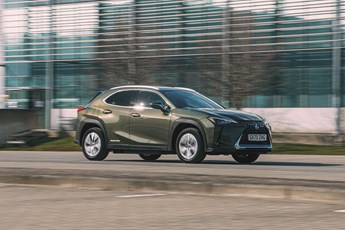
The start point for the best source of fleet information |
First drive: Lexus UX 300e
Date: 23 June 2021 | Author: Guy Bird

|
|
||||||||||||||||||
The Lexus UX 300e is one of the first full-electric compact SUVs on the UK market. There's no Audi, BMW or Jaguar contenders yet and only recently rivals from Mercedes (EQA) and Volvo (XC40 Recharge). Which is slightly perplexing given that, at the launch of the UX hybrid back in 2019, it was one of the last to join the broader non-EV premium compact SUV segment.
Still, the UX clearly stood out among that crowd with just over 4,000 hybrids sold in 2020, despite Covid-19 restrictions. The EV effectively went on sale in the UK in 2021 and, to the end of May, about a fifth of all UX sales were full-electric. That's expected to rise to a third in 2022. Based on the same numbers, the fleet/retail split is 53/47%, so the UX 300e is a significant business car for Lexus.
In terms of exterior looks, the striking but complex cuts, creases and curves remain, although the 300e does get two bespoke wheel designs and front grille shutters, which open and close according to battery level charge (plus a smoother underside, both for better aero). That battery is 54kWh, good for 196 miles with 17in wheels and 190 miles with 18ins. Power for the front-wheel drive 300e is up to 204hp from 176hp for the petrol-electric hybrid, and boot space is greater too due to less hybrid kit to package underneath. The 300e boasts 367 litres with seats up and to the tonneau cover versus 283 for the hybrid AWD and 320 for the FWD. Two recharging ports, an AC at the rear right and a rapid DC at the rear left, take eight hours and 0-80% in 50 minutes respectively to recharge the UX.
Inside, the cabin trim feels more special in places, especially in mid-range Premium Pack spec, featuring ventilated smooth leather upholstery with enveloping seat bolsters. The cocooning cockpit in the model we drove also has the unusual upper dash finish that resembles textured Japanese washi paper (as debuted in the regular UX). The rear seats are bespoke to the 300e but space is arguably a little too cocooning if you're a six-footer, with only okay knee and headroom and weirdly, for any car in 2021, a lack of spaciousness under the front seat for a rear passenger to place their feet. Install only small people there.
Back up front by the gear selector, the trackpad that controls the 7in centre screen (instead of direct touch) is still fiddly but better when its speed is slowed down. Interestingly, Lexus only offers in-house satnav on its Takumi top trim UX, when a 10.3in Premium Navigation system replaces the 7in screen. Standard Apple Carplay and Android Auto integration take up the slack on the lower two trims, and are arguably much better systems, but remember to bring smartphone cables that work with the older, larger-style USB ports. The UX 300e has four, but no new Type-C ones.
To drive, the UX 300e is a simple and pleasant experience, with instant and linear acceleration, a lower, more hatchback-like driving position than most SUVs, a nicely supple ride, very quiet cabin and firm-ish steering. Newly-redundant steering wheel-mounted shifter paddles are put to work to adjust four levels of re-gen, but stick the main gear selector in B for 'brake re-gen' and you'll recoup energy pretty well whatever level you feel comfortable with. There's also a knob situated quirkily high-up on the side of the driver display cowl that twists through various modes if you fancy being sportier or more eco-conscious.
As with all full-electric cars with a meaningful range, the UX 300e attracts only 1% BIK tax this year and next, and still only 5% from 2022-23. Of course, it comes with a hefty price premium over regular-powered or hybrid models, but as a FWD vehicle with a modest 54kWh battery, 204hp and up to 196 miles, the 300e range - from £41,745-53,500 - is considerably cheaper than its EV rivals. The admittedly more powerful, AWD and longer-range Volvo XC40 Recharge (408hp, 78kWh, up to 260 miles) costs from £49,950-56,700, while the Mercedes EQA (228-292hp, 66.5kWh and up to 264 miles) is in a similar space (£44,495-55,995).
If you don't really need that extra 60 miles of range or indeed AWD, the UX 300e represents an interesting choice and feels like a convincingly Asian take on premium, not a German copy. With only a few full EVs in this smaller size of compact SUV right now, it's worth serious consideration.
Lexus UX 300e Premium Plus Pack
P11D: £45,190
Residual value: 42.2%
Depreciation: £26,115
Fuel: £2,328
Service, maintenance and repair: £2,130
Cost per mile: 51p
Range: 196 miles
CO2 (BIK %): 0g/km (1%)
BIK 20/40% a month: £8/£15
Luggage capacity: 367 litres
Battery capacity/power: 54kWh/204hp
Verdict |
8/10 |
|||
 |
|
 |
|
|










